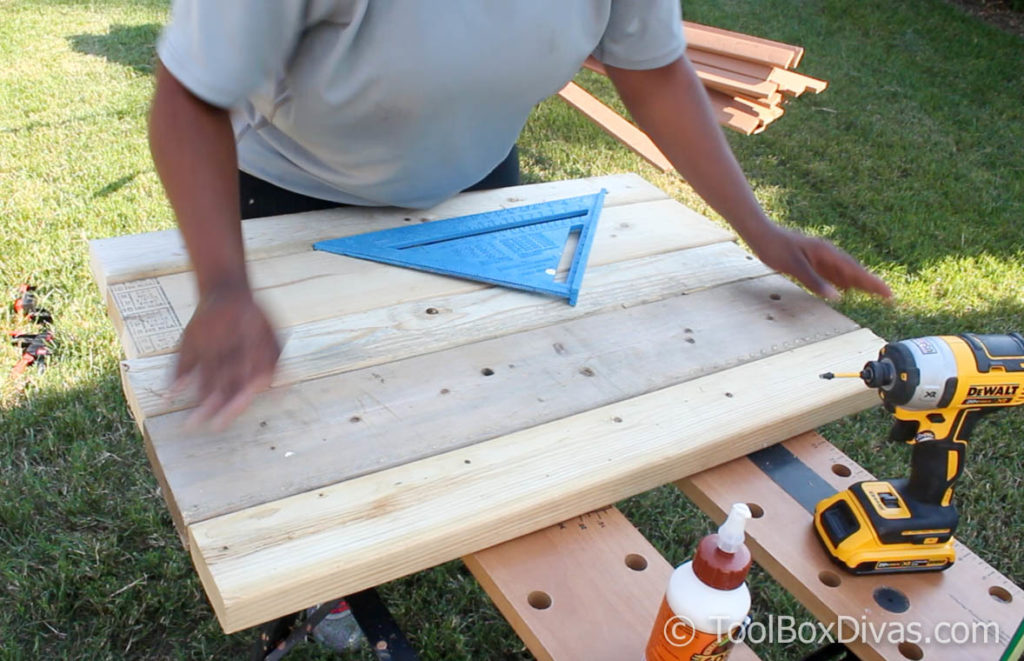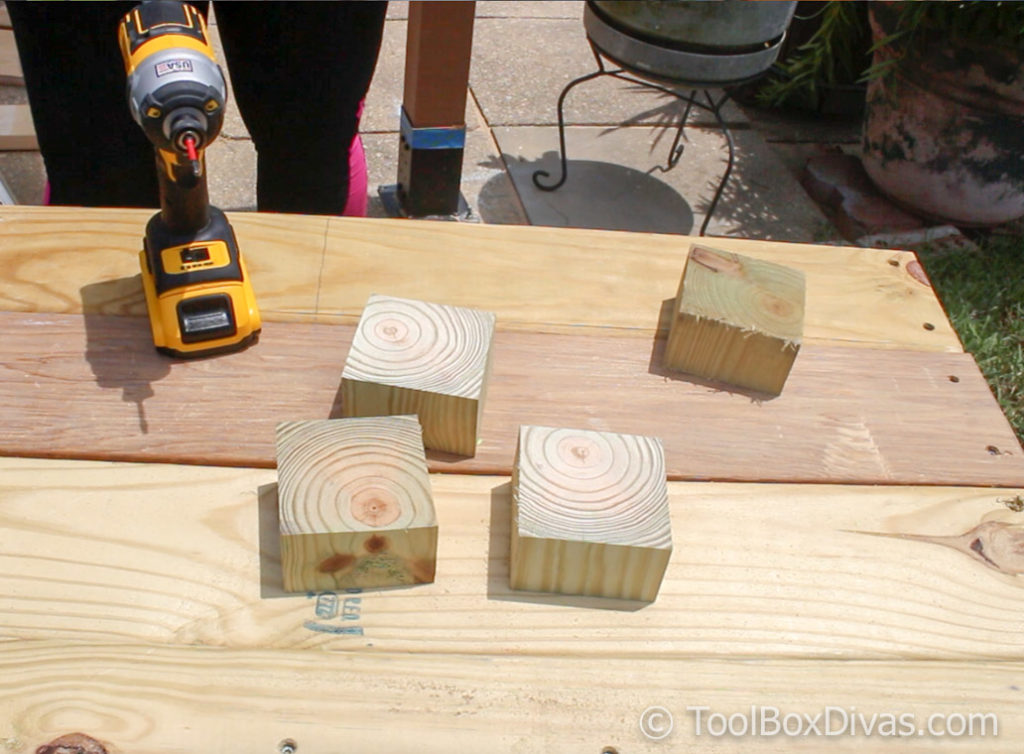How To Build a Large Planter Box Using Scrap Wood
Using a circular saw and drill I will demonstrate how you can turn scrap wood into a large privacy planter for your yard.
*This post is sponsored by The Home Depot.
Last month, I was helping a friend redo his backyard. He had a patio that needed a lot of love. Stay tuned for the full reveal. But he wanted some large planters that he could use to plant roses and create additional privacy in his backyard. Now when working off-site away from my garage it is challenging. I’m not hauling a ton of heavy equipment. It’s just not practical. He didn’t have a lot of tools. So I had come up with a solution that didn’t require a lot of tools. So using just a circular saw and drill or impact driver in my case, I turned some scrap wood left over from building my dining table and a few other projects into a practical outdoor planter box.
Before I get into the build let me tell you about the saw I used. It was the Dewalt FLEXVOLT 60-Volt MAX Lithium-Ion Cordless Brushless 7-1/4 in. Wormdrive Style Circular Saw and ya’lllllllll Let me tell you! It is life changing! Hahahaha. It’s not too heavy and paired with a Diablo 7-1/4 in. x 24-Teeth Tracking Point Framing Blade it cuts through everything with ease. At my friend’s house, I was able to set up a workstation and cut everything down to size easily and quickly. I can honestly say that I had never used a cordless circular saw with such power and force. And after making all those cuts the battery didn’t skip a beat. It barely took away from the battery life. 
I was able to turn all these scrap wood pieces Into this:
Into this:
Well, it was little more life like that this Hahaha. But it turned out so well I decided to make plans to accompany this scrap wood planter box project.
GET THE PRINTABLE PLANS
Here’s What You’ll Need:
- Scrap wood – 2x3s, 2x4s, 2x6s and 1x6s & 4x4s for the bottom
- Spax Exterior Scews – 2 1/2in.
- Waterproof Wood Glue
- Everbilt 6 in. Zinc-Plated Flat Corner Brace (Optional)
Tools I used:
- Dewalt FLEXVOLT 60-Volt MAX Lithium-Ion Cordless Brushless 7-1/4 in. Wormdrive Style Circular Saw
- Diablo 7-1/4 in. x 24-Teeth Tracking Point Framing Saw Blade
- Dewalt 20-Volt MAX XR Lithium-Ion Cordless Brushless Impact Driver
- Clamps – I used BESSEY 18 in. 1-Hand Trigger Clamp with 3-1/2 in. Throat Depth
- Speed Square
OK Let’s Get Dirty!
Like I stated earlier, this planter box was built using a bunch of scrap wood pieces I had around the shop. I’m one of those people that hates throwing away a good piece of wood, even if I have no room to store it. LOL I know it’s an issue LOL. But in this case, it came in extremely handy being a wood hoarder. I had a ton of 2×6 and 2×4 pieces under 40 inches each. The problem was I didn’t have enough 2x4s or 2x6s to make a complete project out of either board type alone. So I decided to join the two. Afterall, 2x4s and 2x6s are both the same thickness (1 1/2in.).

Creating the 2 side panels
So starting with a 2×4 piece cut to 31 inches I used glue and connected a 2×6 board also cut to 31 inches. I kept going until I had 3 – 2x4s and 2 – 2x6s lined up. Now I’ll admit, adding wood glue given what I’m about to do might be overkill. But I wanted to cover all my bases. Hahaha . The panels will be a little over 20 inches high.
Making sure all the boards were even and lined up, I screwed 2 – 2×3 boards to each side of the boards, leaving 1 1/12in. space from either ends. I pre-screwed the Spax screws into the 2×3 boards before screwing it into the 2×4 and 2×6 side panels for the planter boxes.

To help with the spacing and to ensure I was 1 1/2in. from the edge I used a scrap 2×6 board.


I recommend this trick. It’ll also help you hold the 2×3 in place while you screw it down.  With one of the front and back panel complete for the planter box set it aside and do everything listed one more time. You will need two side panels.
With one of the front and back panel complete for the planter box set it aside and do everything listed one more time. You will need two side panels. 
Bringing it all together
 Starting with a 2×4 piece cut to 16 1/2inches and then 2×6 boards attach the boards to the perpendicular to the front and back panels by screwing it into the 2×3 board.
Starting with a 2×4 piece cut to 16 1/2inches and then 2×6 boards attach the boards to the perpendicular to the front and back panels by screwing it into the 2×3 board. This is the simple part. The pieces should fit together like a puzzle. Screw everything in place by joining the back and front panels.
This is the simple part. The pieces should fit together like a puzzle. Screw everything in place by joining the back and front panels. 
The Bottom
 Finally, I screwed the 1×6 boards to the bottom lining it up evenly. There was som over lapping so using some painters tape I marked where I needed to cut using the circular saw.
Finally, I screwed the 1×6 boards to the bottom lining it up evenly. There was som over lapping so using some painters tape I marked where I needed to cut using the circular saw. The tape was an easier way of gauging where to cut given I didn’t have a rip gauge for the saw.
The tape was an easier way of gauging where to cut given I didn’t have a rip gauge for the saw. 
I then added legs by using treated 4×4 pieces cut to 2 inches.


Finishing up
Once everything was in place I gave the planter a light sanding. The intent was not to get the boards perfected squared. I only wanted to reduce any splinters before I proceded with staining it with a solid exterior stain. So this is the part I wasn’t sure if I actually needed. I’m not a gardener. In fact, everything I have tried growing, outside of perennials have pretty called it. But I saw this once in a planter to I thought it couldn’t hurt. Also I read that with wood planters you should line it with plastic of ground liners. I had a ton of this left over from planting some perinnials in my garden.
So this is the part I wasn’t sure if I actually needed. I’m not a gardener. In fact, everything I have tried growing, outside of perennials have pretty called it. But I saw this once in a planter to I thought it couldn’t hurt. Also I read that with wood planters you should line it with plastic of ground liners. I had a ton of this left over from planting some perinnials in my garden. 
So I lined the interior of the planter with ground liner, stapling it to the inside walls of the planter box.  Finally, I stained the planter with a solid exterior stain.
Finally, I stained the planter with a solid exterior stain.  To add an additional decorative finish, I added some flat corner braces to the front sides of the planter.
To add an additional decorative finish, I added some flat corner braces to the front sides of the planter. 
And that’s all. Not bad for a scrap wood project.

But I loved the way this turned out to so much I made a larger one with plans. See I got you covered.
GET THE PRINTABLE PLANS

I still need to add the corner braces to the larger planter, but I like it.

What I loved about the Dewalt FLEXVOLT Wormdrive Style Circular Saw
- The power. I had never used a cordless circular saw that has as much strength as the Dewalt Flexvolt Wormdrive.
- This thing is all steel. NO PLASTIC to be found. So it’s rugged and can handle a fall or 3.
- That rear handle makes it ergonomic and easy to hold.

What be improved
- The dust collection set up. The dust comes right back up into your face. So where a mask and eyewear. I haven’t found a dusk collection port adapter for it yet. I will definitely share with you once I find a solution. So for now this will only be used outdoors. It’s too much sawdust to use indoor in the shop.

- I was also surprised that the saw didn’t come with a rip fence. This was by no means a deal breaker. But I thought that at this price range it would be expected.
All in all, this is an excellent tool. I highly recommend this circular saw to the intermediate and advanced DIYER and contractor.
I acknowledge that The Home Depot is partnering with me to participate in the ProSpective 2018 Campaign. As a part of the Program, I am receiving compensation in the form of products and services, for the purpose of promoting The Home Depot. All expressed opinions and experiences are my own words. My post complies with the Word Of Mouth Marketing Association (WOMMA) Ethics Code and applicable Federal Trade Commission guidelines.







Hi, You did a great job. This is amazing idea to build a planter box. I want to build it, but I have a question for you. You use here Dewalt FLEXVOLT 60-Volt MAX Lithium-Ion Cordless Brushless my question is I have a Bosch Bare-Tool CCS180B Cordless Circular Saw can I make it by using this. Thanks in advance for your suggestion.
Thank you and good luck with your build. The tools I use are what I use and love. This is a simple project designed for anyone to do.
This is lovely and exactly what I need for my own home, even though I’m not going to lie anybody – I’m entirely threatened by such a venture. In any case, stunning beautiful view.
Thank you so much John! Don’t be scared you got this!